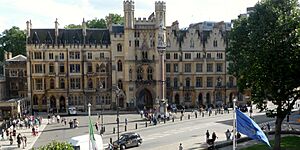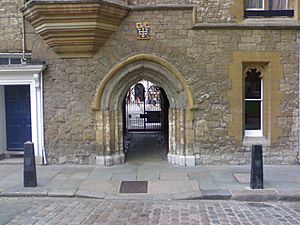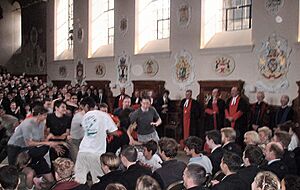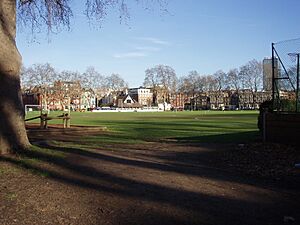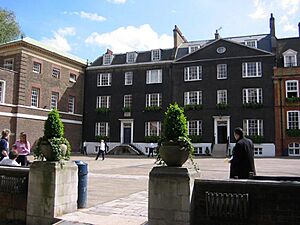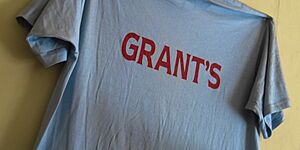Westminster School facts for kids
Quick facts for kids Westminster School |
|
|---|---|
 |
|
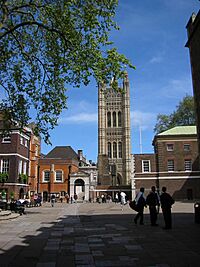 |
|
| Address | |
|
Little Dean's Yard
London, SW1P 3PF
England
|
|
| Coordinates | 51°29′54″N 0°07′42″W / 51.4984°N 0.1284°W |
| Information | |
| Type | Public school Private day and boarding school |
| Motto | Latin: Dat Deus Incrementum (God Gives the Increase) |
| Religious affiliation(s) | Church of England |
| Established | Earliest records date from the 14th century, refounded in 1560 |
| Founder | Henry VIII (1541) Elizabeth I (1560 – refoundation) |
| Local authority | City of Westminster |
| Department for Education URN | 101162 Tables |
| Chairman of Governors | Mark Batten |
| Head Master | Gary Savage |
| Staff | 105 |
| Gender | Boys Coeducational (Sixth Form) |
| Age | 13 (boys), 16 (girls) to 18 |
| Enrolment | 747 |
| Houses | Ashburnham Busby's College Dryden's Grant's Hakluyt's Liddell's Milne's Purcell's Rigaud's Wren's |
| Colour(s) | Pink |
| Publication | The Elizabethan |
| Alumni | Old Westminsters ("OWs") |
Westminster School is a famous private school in Westminster, London, England. It is located very close to Westminster Abbey. The school's history goes back to a charity school started by monks before the Norman Conquest in 1066. It has been continuously open since the early 1300s.
Westminster School is known for its excellent academic results. About half of its students go on to study at top universities like Oxford or Cambridge. In 2023, over 82% of its students achieved top grades (A* or A) in their A-levels. The school is considered one of the best private schools in the world.
Many famous people have studied here. Three Nobel Prize winners attended Westminster School: Edgar Adrian (for medicine), Sir Andrew Huxley (also for medicine), and Sir Richard Stone (for economics). The famous philosopher John Locke was also a student. Seven British Prime Ministers, who are the leaders of the UK government, also went to Westminster School.
Boys can join the school at age 13 after passing exams. Girls join for the Sixth Form (the last two years of high school) at age 16. About a quarter of the 750 students live at the school as boarders.
Contents
History of Westminster School
The first records of a school at Westminster are from the 1340s. Some parts of the school buildings are even older, dating back to the 900s!
In 1540, King Henry VIII closed down many monasteries, including the one at Westminster Abbey. However, he made sure the school survived by giving it a special royal charter. This meant the school, called the Royal College of St. Peter, continued with 40 "King's Scholars" whose education was paid for by the King. By this time, Westminster School had become a "public school," meaning it was open to students who paid fees, not just those taught privately.
Queen Elizabeth I officially re-established the school in 1560. She set up new rules for choosing 40 King's Scholars. Queen Elizabeth often visited her scholars, and 1560 is now seen as the school's official founding year.
A very important Head Master named Richard Busby led the school for many years. He was known for his strong teaching of classical subjects like Latin and Greek. He stayed in charge through a very difficult time in English history, including the English Civil War.
Until the 1800s, students mainly studied Latin and Greek. The school was very close to the Palace of Westminster, where the government meets. In 1868, a new law separated the school legally from Westminster Abbey, though they still work closely together.
Westminster School is unique because it chose to stay in central London, unlike some other schools that moved to the countryside. It even rebuilt its roof after it was damaged during World War II bombings.
In 1943, Westminster Under School was created for younger day students (ages 7-13). It later moved to Vincent Square, near the main school's sports fields.
The first female student joined the school in 1967, and girls became full members in 1973. The school plans to welcome girls into Year 9 starting in 2028, becoming fully co-educational by 2030.
School Buildings and Location
Westminster School is located within the historic area of Westminster Abbey. Its main buildings are around a private area called Little Dean's Yard.
- College Hall is a dining hall from the 1300s. It's one of the oldest medieval dining halls still used daily!
- College was designed in 1729 by the Earl of Burlington, based on ideas from Sir Christopher Wren. It overlooks the beautiful College Garden, which is thought to be the oldest garden in England, continuously used for about 1,000 years.
- School is the main hall, originally built in the 1090s as the monks' dormitory. It's used for weekly Latin prayers, exams, and big concerts. The walls are covered with the coats of arms of many former students.
- The school's main entrance, the gateway, was also designed by the Earl of Burlington. Students used to hire a stonemason to carve their names into it!
- Ashburnham House holds the library and the Mathematics Department. It was built around the 1600s. In 1731, a fire here damaged many old books and manuscripts.
The school's playing fields are about half a mile away at Vincent Square. This is a large green space in central London, covering about 13 acres (5 hectares). The school also has a boathouse for rowing on the River Thames in Putney.
In 2011, the school bought Lawrence Hall, London and turned it into a Sports Centre. It has facilities for climbing, martial arts, fencing, and more.
School Traditions
Westminster School has many unique and old traditions:
The Greaze Pancake Race
Every year on Shrove Tuesday, the school holds "The Greaze." The head cook throws a special pancake over a high bar in the School Hall. Students then rush to grab the largest piece of the pancake within one minute. The student with the biggest piece wins a gold coin! The Dean of Westminster and the Head Master watch this fun event.
Coronation Acclamation
Westminster School has a special privilege: its King's (or Queen's) Scholars are the first ordinary people to cheer for a new King or Queen at their coronation in Westminster Abbey. They shout "Vivat Rex/Regina" (which means "Long live the king/queen!" in Latin). This tradition dates back to the coronation of King James II.
Commem Service
Each year, the school remembers its supporters with a special service in Westminster Abbey. This service is partly in Latin. The Captain of the King's Scholars places a wreath of pink roses on the tomb of Queen Elizabeth I.
House of Commons Access
The King's Scholars have special access to the gallery of the British House of Commons, where politicians meet. This tradition started to stop students from climbing onto the roofs of the Palace of Westminster!
Latin Prayers
Even though the school is separate from the Abbey, it is still connected to the Church of England. Students attend services in the Abbey at least twice a week. Every Wednesday, there's an assembly called "Latin Prayers" where the Head Master leads the school in chanting prayers in Latin. The school has its own special way of pronouncing Latin, called "Westminster Latin."
Latin Plays
For centuries, students have performed plays in Latin. These plays often include a funny ending about current events. In the past, some plays were even performed for Queen Elizabeth I!
Westminster School Language
The school has its own special words for things:
- Years 9, 10, 11, 12, and 13 are called Fifth Form, Lower Shell, Upper Shell, Sixth Form, and Remove.
- 'Green' means Dean's Yard.
- 'Yard' means Little Dean's Yard.
- 'School' refers to the main school hall.
- 'Fields' means Vincent Square.
- 'Station' means sport.
- 'Water' means rowing.
Sports at Westminster School

Westminster School offers many sports. It has three Eton Fives courts. Students often compete nationally and internationally in rowing and fencing.
The Westminster School Boat Club is the oldest rowing club in the world. Its boathouse is on the River Thames in Putney. The school's color for rowing is pink.
Since 1810, the school's main sports area has been Vincent Square. This large green space is used for football, cricket, tennis, and netball. The school also uses other sports facilities nearby, including an astroturf field and the Queen Mother Sports Centre.
Westminster School played in the very first school cricket match against Charterhouse School in 1794. The school also played a big part in developing the rules for modern football (soccer). In the 1840s, students played football in the cloisters, which led to rules that allowed passing the ball forward. This was different from other schools that focused on dribbling. By 1867, the Football Association adopted rules that allowed forward passing, thanks to Westminster and Charterhouse.
School Houses
The school is divided into 11 "houses." Some are for day students who go home after school, and others are boarding houses where students live. All King's Scholars must live in College House.
Each house has a "Housemaster" (a teacher in charge of the students' well-being) and a "Head of House" (an older student who helps organize activities). Houses are important for student care, social events, and sports competitions. All day houses are mixed-sex, and all houses welcome girls.
| House | Abbr. | Founded | Named after | Colours | Pupils | ||
|---|---|---|---|---|---|---|---|
| Boarding | Day | ||||||
| College | CC | 1560 | n/a | Dark green | Mixed | None | |
| Grant's | GG | 1750 | The "mothers" Grant – landladies who owned the property and put up boys in the days before boarding existed, when the School only accommodated Scholars; the oldest house in any of the Public Schools. | ■ | Maroon on light blue | Mixed | Mixed |
| Rigaud's | RR | pre-1896 (rebuilt) | Stephen Jordan Rigaud – former schoolmaster | ■ | Black on orange (Tie uses orange on black) | Mixed | Mixed |
| Busby's | BB | 1925 | Richard Busby – former headmaster | ■ | Dark blue on maroon | Mixed | Mixed |
| Liddell's | LL | 1956 | Henry Liddell – former headmaster | ■ | Blue on yellow (ties are yellow on black or yellow and silver on black) | Mixed | Mixed |
| Purcell's | PP | 1981 | Henry Purcell – former organist of Westminster Abbey | ■ | White on purple | Girls | Boys |
| Ashburnham | AHH | 1881 | The Earls of Ashburnham whose London house is now part of the School | ■ | Light blue on dark blue | None | Mixed |
| Wren's | WW | 1948 | Christopher Wren | ■ | Pink on black (Blue and Maroon used on ties) | ||
| Dryden's | DD | 1976 | John Dryden | ■ | Silver on red (Tie uses separated silver and red stripes on dark blue) | ||
| Hakluyt's | HH | 1987 | Richard Hakluyt | ■ | Yellow on blue | ||
| Milne's | MM | 1997 | A. A. Milne | ■ | Black on orange (Tie uses Red and Yellow) | ||
Famous People Who Attended Westminster School
Many notable people have been educated at Westminster School. They are known as "Old Westminsters." Here are a few examples:
- Ben Jonson (1573–1637), a famous poet and playwright.
- John Dryden (1631–1700), another important poet and playwright.
- John Locke (1632–1704), a very influential philosopher.
- Sir Christopher Wren (1632–1723), a famous architect who designed St. Paul's Cathedral.
- Robert Hooke (1635–1703), a brilliant scientist.
- Henry Purcell (1659–1695), a well-known composer.
- Jeremy Bentham (1748–1832), a lawyer and philosopher.
- A. A. Milne (1882–1956), the author of Winnie-the-Pooh.
- Sir John Gielgud (1904–2000), a famous actor.
- Sir Peter Ustinov (1921–2004), an actor, writer, and director.
- Tony Benn (1925–2014), a well-known politician.
- Andrew Lloyd Webber (born 1948), a famous composer of musicals.
- Helena Bonham Carter (born 1966), a popular actress.
- Nick Clegg (born 1967), a former Deputy Prime Minister of the UK.
- Dido Armstrong (born 1971), a successful musician known as "Dido."
- Michael Penniman (born 1983), a musician known as "Mika."
- Alfred Enoch (born 1988), an actor who appeared in the Harry Potter films.
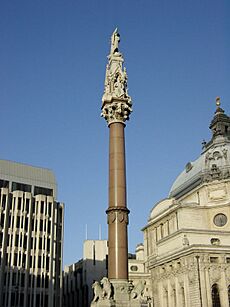
Victoria Cross Winners
Six former students of Westminster School have been awarded the Victoria Cross. This is the highest award for bravery in the British armed forces.
Images for kids
-
The School often uses St John's, Smith Square as a venue for major musical concerts.
-
The phoenix which was placed on the roof of the school in the 1950s to commemorate the school's resurgence after World War II
See also
 In Spanish: Westminster School para niños
In Spanish: Westminster School para niños


